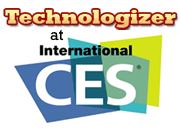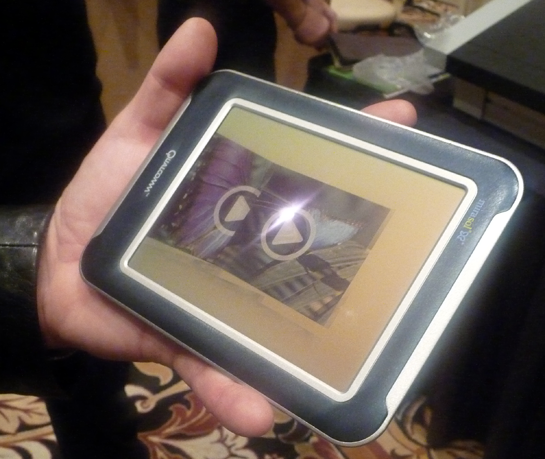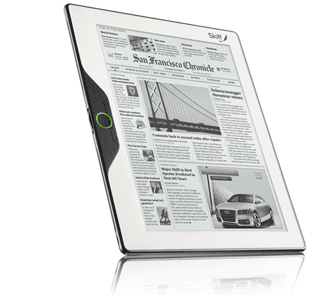I think the iPad’s impact on the market for dedicated e-readers such as Amazon’s Kindle is going to be gigantic. But here’s interesting research from NPD saying that almost everybody who’s invested in an e-reader is a happy camper. I wonder if that’ll change once the the iPad is out and it’s clearer how extensive Apple’s content offerings will be?
Tag Archives | E-Readers
Asus’s E-Reader Breakthrough?
A “6in, high-brightness, OLED colour screen that should run for a whopping 122 hours on one battery charge“? That’s either one of the biggest breakthroughs in display technology in eons, or a misunderstanding, or partial information that doesn’t mention some gigantic gotcha. I hope it’s the first of these possibilities, but I’m not placing any bets…
No comments
Electronic Paper Gets Flexible
When I first saw E-Ink electronic paper more than a decade ago at MIT’s Media Lab, it was in the form of a big, ad banner that was as flexible as a piece of dead-tree paper. These days, E-Ink is pervasive–or at least as pervasive as e-readers such as Amazon’s Kindle and Barnes & Noble’s Nook are–but so far, it’s always been enclosed in a rigid case.
But here are some fascinating photos of a 19-inch LG electronic paper display that looks like a floppy piece of newspaper. I’m not clear what an e-reading device based on this screen would look like–processors, memory, and batteries aren’t so flexible–but the idea of an electronic newspaper you can fold up is entertaining, at least. Even though I’m not sure offhand what the benefit would be.

So are you intrigued?
5 comments
Too Many eBook Readers
The Las Vegas Convention Center is bursting at the seams with new e-readers, and for every one with a high profile. there seem to be seventy-three anonymous ones from companies you’ve never heard of. Hanvon had rather feral-looking pseudokindles and fauxsonys, and that slogan-“New Book, New Life”–kind of scares me…

One comment
More E-Reader Impressions: Skiff
 Unlike Plastic Logic, new e-reader arrival Skiff isn’t showing off its stuff on the show floor. But it’s demonstrating its reader–which it’s only saying will arrive sometime in 2010, at an unspecified price–in a private room. I got a sneak peek, and came away intrigued.
Unlike Plastic Logic, new e-reader arrival Skiff isn’t showing off its stuff on the show floor. But it’s demonstrating its reader–which it’s only saying will arrive sometime in 2010, at an unspecified price–in a private room. I got a sneak peek, and came away intrigued.
Physically, the Skiff reader looks a lot like Plastic Logic’s Que–it has a magazine-sized screen, a touch interface, and a thin case. Both readers use their extra real estate and resolution to render pages with more style and fidelity than is afforded by the smaller screens on the Kindle and Nook. But while Plastic Logic is pitching the Que as a business tool, Skiff is focusing on making magazines and newspapers easy to get and read. The demo I got involved digital versions of the Wall Street Journal and Esquire that maintained a newspaper and magazine-like feel, respectively, along with the typography, art, and layouts you associate with those two publications. They’re not exact replicas of the print incarnations, though–they’re scaled to the available screen space on the Skiff. And the ads provide some interactivity, such as a car one that lets you find a local dealer.
4 comments
Plastic Logic’s Que E-Reader: Revealed, Finally
 Plastic Logic has been teasing us with previews of its e-reader–now dubbed the Que proReader–for sixteen months. This morning at CES, it formally announced the product on the show floor, complete with demos of the final version and full details on features, pricing, and availability.
Plastic Logic has been teasing us with previews of its e-reader–now dubbed the Que proReader–for sixteen months. This morning at CES, it formally announced the product on the show floor, complete with demos of the final version and full details on features, pricing, and availability.
As Plastic Logic has said all along, the Que is based on its proprietary plastic transistor technology (which allows for a large, lightweight, glass-free display), has a screen the size of an 8.5″-by-11″ piece of paper, uses a touchscreen interface, and is aimed at businessfolk who “need to read” rather than those who read for pleasure. It’s signed content deals with business-oriented media brands such as the Wall Street Journal, Forbes, and Fast Company (and my old employer IDG), it lets you drag and drop Microsoft Office documents and other business files from your PC to the e-reader, and it has extensive tools for annotating and organizing documents. It also lets you view your Exchange calendar and has a complementary BlackBerry app which lets you transfer files to the Que.
19 comments
This New Qualcomm Technology Gives E-Readers Color
 It’s still early here at the Consumer Electronics Show–the halls bursting at the seams with exhibitors open later this morning for the first time. But if someone asked me what the most interesting thing is that I’ve seen so far, the answer’s easy: It’s the low-power color displays for e-readers and other gadgets from Qualcomm’s Mirasol division, which the company was showing off at the Digital Experience event Wednesday night.
It’s still early here at the Consumer Electronics Show–the halls bursting at the seams with exhibitors open later this morning for the first time. But if someone asked me what the most interesting thing is that I’ve seen so far, the answer’s easy: It’s the low-power color displays for e-readers and other gadgets from Qualcomm’s Mirasol division, which the company was showing off at the Digital Experience event Wednesday night.
Mirasol’s technology produces screens that look a lot like the E-Ink ones found on nearly every e-reader to date–they’re unilluminated and therefore look better in bright light than in dim environments. But Mirasol’s displays, unlike E-Ink, do color and have decent refresh rates. If the shipping version of the display technology’s as impressive as the demo, that means that it’ll allow for e-readers with color pages, video, and slicker user interfaces. Here’s a photo of a concept device that doesn’t do the technology justice.

The Mirasol technology, which involves tiny mirrors creating colors by refracting light, doesn’t have anything to do with how E-Ink works, but it shares some of the virtues that make it a good candidate for e-reading devices, including extremely low power consumption. (Like E-Ink, it only draws power when the page is being changed, not when an image is static.) Actually, a Mirasol representative told me that it uses far less power than even E-Ink.
The tech demo at Digital Experience knocked my socks off, but Mirasol isn’t quite ready to go into consumer products yet. Qualcomm says to expect an e-reader incorporating the the technology by the third quarter of the year.
4 comments
Skiff, an Interesting New E-Reader. But Do We Need Another One?
 Among the gazillion products making their debut this week at the Consumer Electronics Show: Skiff, the first reader from a new spinoff of publishing behemoth Hearst. The Skiff has the largest (11.5″) and highest-resolution (1200 by 1600) screen of any e-reader to date; it uses a new “metal foil” technology from LG instead of glass, making the gizmo sturdy and thin; and it emphasizes magazines and newspapers more than most e-readers, as you might expect of a reader that emerged from Hearst. (Kindle and Nook both offer magazines and books, but in a drab, text-oriented format that looks more like a 1986 CompuServe screen than a real periodical or a Web page.)
Among the gazillion products making their debut this week at the Consumer Electronics Show: Skiff, the first reader from a new spinoff of publishing behemoth Hearst. The Skiff has the largest (11.5″) and highest-resolution (1200 by 1600) screen of any e-reader to date; it uses a new “metal foil” technology from LG instead of glass, making the gizmo sturdy and thin; and it emphasizes magazines and newspapers more than most e-readers, as you might expect of a reader that emerged from Hearst. (Kindle and Nook both offer magazines and books, but in a drab, text-oriented format that looks more like a 1986 CompuServe screen than a real periodical or a Web page.)
Whatever Skiff is, it’s definitely not an unimaginative Kindle wannabe, and I’m looking forward to seeing it at the show in a few days. But I’m not unreservedly excited about the profusion of new e-reading devices that are arriving. We have a sufficient supply of hardware–at least hardware that utilizes monochrome e-ink displays. And e-reading is going to be a hundred times more exciting once the industry agrees on some standards that make these devices as compatible with an array of content as Web browsers have been from day one.
Skiff apparently plans to license its platform to other devices too, and that’s smart–but it’s still a proprietary format that won’t work with every major e-reader. To mention CompuServe yet again, we’re still stuck in the equivalent of the era when CompuServe, AOL, GEnie, and others duked it out by building their own proprietary technologies and licensing exclusive content. You think it’s a coincidence that the online world only really took off when the Web knocked down those walls?
Here’s the e-reader development I most want to see: An e- format that’s largely based on existing HTML, CSS, JavaScript, and other Web technologies, with a dash of something along the lines of Google Gears to make it possible to peruse publications when you’re not online, plus some sort of mechanism for enabling paid content. Something, in other words, not wildly different from the Web as we know it, except in a form that provides more of the visual elegance and browsability of print. Seems simple enough to me…
2 comments
Sony Readers Getting Subscriptions
Sony’s Reader e-readers have a decent selection of books, but–unlike the Kindle and Nook–they haven’t done newspapers or magazines. (There’s an RSS reader feature, but as far as I can tell, it’s been busted for months.) But Sony just struck a deal to bring News Corp. content, including the Wall Street Journal, MarketWatch, and the New York Post, to its e-readers. I hope more’s on the way–especially now that the company’s launching the Reader Daily Edition, which can snag periodical content wirelessly as it’s available.
No comments
Kindle Goes International
Amazon, which started selling the Kindle internationally back in October without fully localizing it, is now distributing the Kindle iPhone app in sixty countries. Good news for folks around the world who are interested in reading bestsellers and other recent, still-in-copyright tomes on their iPhones. (I have a Kindle but do most of my Kindling on my iPhone these days–reading a few pages at a time when I’m in line at the grocery store or otherwise confronted with a sliver of free time I can devote to a book.)
